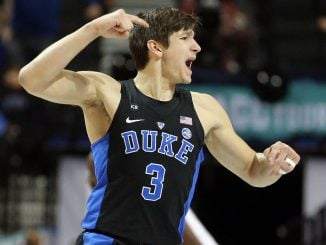
WASHINGTON, D.C. — Duke seemed to have all the pieces in place for an NCAA title run, but instead, the Blue Devils will be home for the Final Four.
The Blue Devils had the country’s most dynamic player in Zion Williamson. Fellow freshman RJ Barrett had the second-highest point total in a season in school history, regardless of class. Point guard Tre Jones shattered the school record for assist-to-turnover ratio — 3.62, compared to the 22-year-old previous mark of 3.02.
The team also had two other McDonald’s All-Americans on the roster in Marques Bolden and Cam Reddish, as well as role players Jack White, Javin DeLaurier and Jordan Goldwire.
Duke went into the Elite Eight game with Michigan State with wins against the other three Final Four teams — Virginia (twice), Auburn and Texas Tech.
So what went wrong?
Shooting woes
Duke was not good from outside, to put it mildly. The Blue Devils’ .308 shooting percentage from three was the lowest in school history by more than 40 points. It was also 326th in the nation out of 353 teams. The other teams that shot as bad as Duke had a .415 winning percentage this season, and only two other teams with 25 or more wins — FSU and LSU — were within 100 spots of Duke’s ranking in 3-point accuracy.
The lack of an outside threat allowed teams to collapse on the inside to try to control Williamson’s attacks at the basket.
None of that might have been a major problem had Duke simply stopped shooting them, but the Blue Devils’ 903 3-point attempts were the second-most in a season in school history.
Toeing the line
Duke also struggled from the free-throw line, a problem given that the team’s stars had a playing style that would send them there repeatedly at the end of close games. Duke’s .686 accuracy on free throws was its lowest since the 1995 team that went 13-18.
Barrett hit just two of four from the charity stripe in the final five minutes of the one-point loss to Michigan State — and one of his makes was when he was trying to miss to give Duke the chance at an offensive rebound.
In their previous two-point win over Virginia Tech in the Sweet 16, Tre Jones missed the front end of a one-and-one with 29 seconds left, allowing the Hokies to shoot for a chance to win.
In the one-point win that got Duke to the Sweet 16, Barrett’s game-winning tip-in came after Williamson missed a potential game-tying free throw with seconds left.
Possible Discord
All season, coach Mike Krzyzewski and the players raved about how close-knit the team was, but there were signs near the end that all was not well.
Cam Reddish was a late scratch for the Sweet 16 game with a knee injury. The comments afterward seemed to indicate that it was Reddish’s decision not to make a go of it, rather than the Duke medical staff’s.
“He’s had a little bit of problem with his knee,” Krzyzewski said. “It’s not structural — nothing structural. A jumper’s knee, a tendonitis. I guess there are a number of different things. At different times it can inhibit you, or you feel pretty good, and then you can play. Or you can work yourself through it.”
Some of Reddish’s teammates were more direct.
“They told me I was going to start with 10 minutes on the clock left (before tipoff) because Cam decided he wasn’t going to play,” Alex O’Connell said.
“I told him it’s OK. You don’t have to play if you think something is bothering you,” Williamson said. “We got you. Worry about yourself.”
Following Duke’s last-second loss to Michigan State, where Barrett had the ball for the final two plays, Williamson indicated that Duke should have called a different play, lending to more speculation that there were issues beneath the surface, as there are with just about any team over the long season.
Continuity
The failure of Duke and Kentucky to make the Final Four has been heralded by many as proof that using one-and-done freshman is a flawed strategy. While Michigan State’s experience was likely a key factor in Duke’s loss, the Blue Devils’ inexperience was compounded by the team’s injury struggles.
In the final 24 games of the season, Duke had its starting lineup intact from start to finish in just nine games. Since the Feb. 20 loss to North Carolina where Williamson’s shoe blew out, the starting five has been intact just twice — in Duke’s first two NCAA games.
The lack of continuity, combined with Duke’s shooting from outside and the line, helped to set the table for an earlier-than-expected elimination.



